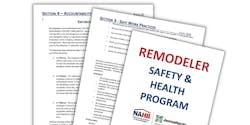A written safety plan is an essential part of protecting workers and others on a construction jobsite. To make it easier for remodeling firms to prepare such plans, NAHB recently published the free Remodelers Safety & Health Program, a model safety program specifically for residential remodeling projects.
The Remodelers Safety & Health Program contains the materials needed to effortlessly set up a safety program and is intended to be used by management, who can take the safety program and use it to make sure their project sites have a well-structured safety plan. The program is flexible and editable so that remodelers can develop safety plans that address the safety challenges of each construction project.
Fit for Small Businesses
The program is intended to cover company employees only and is designed with small companies in mind. This is a practical model program, complete with forms and documentation to help smaller businesses develop and maintain an effective safety program without hiring an additional employee or consultant. NAHB will periodically revise the program to ensure it includes the latest information remodelers need.
Remodelers are encouraged to reproduce this program, or any portion of it, for use in their own companies. The Remodeler Safety & Health Program is meant to be adaptable—not all the information is necessarily applicable to every remodeling project.
The Remodeler Safety & Health Program is made up of five sections: Roles & Responsibilities; Hazard Identification & Assessment; Safe Work Practices; Accountability; and Incident Response. Begin with the “Start-up Checklist” that walks remodelers and superintendents through each of the sections when beginning a new program.
Downloadable and Customizable
Download the complete safety program in English or Spanish from the Remodelers Safety Program Toolkit page on nahb.org and use the forms to execute the program and display on jobsites.
Remodelers can print out pages 6 through 54 of the safety-plan document, which makes up the program. Use the cover page, table of contents, and three-ring binder divider tabs as the basis of an organized, site-specific safety plan. Separate and customize each section and then insert the sections into a three-ring binder. Keep the binder on site and train employees to refer to it regularly as the project progresses.
Take these steps to make the plan as effective as possible:
Management should review and understand the Safety & Health Policies and Procedures. Every employee of the company should review the program and then sign the employee commitment to Safety and Health.
• Conduct an initial assessment of existing hazards, exposures, and control measures.
• Identify and select methods for eliminating, preventing, or controlling workplace hazards, including engineering solutions.
• Review and understand company enforcement policy.
• Review and understand the basic emergency action plan to prepare for an evacuation and the procedures to investigate any incident that occurs.
• Take advantage of additional resources available on the Toolkit page, including various forms and checklists.
Residential construction can be a dangerous job. But with proper safety policies and programs in place and diligent adherence to them, jobsites can be accident-free and efficient. NAHB is committed to promoting a culture of safety for all businesses in the home building and remodeling industry.
